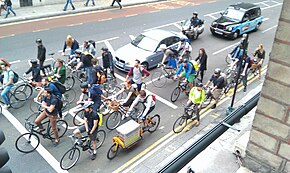
Cycling is a popular mode of transport and leisure activity within London, the capital city of the United Kingdom. Following a national decline in the 1960s of levels of utility cycling, cycling as a mode of everyday transport within London began a slow regrowth in the 1970s. This continued until the beginning of the 21st century, when levels began to increase significantly—during the period from 2000 to 2012, the number of daily journeys made by bicycle in Greater London doubled to 580,000.[a] The growth in cycling can partly be attributed to the launch in 2010 by Transport for London (TfL) of a cycle hire system throughout the city's centre. By 2013, the scheme was attracting a monthly ridership of approximately 500,000, peaking at a million rides in July of that year.[1] Health impact analyses have shown that London would benefit more from increased cycling and cycling infrastructure than other European cities.[2]
Cycling conditions in the city have in recent years been perceived as unsafe by cyclists.[3] A spate of cycling deaths in London occurred in November 2013, drawing criticism of TfL's cycle facilities and sparking protests and calls for safety improvements from politicians, cycling organisations and the media, as well as differing views on the extent to which poor cycling contributes to safety risks for both cyclists and other road users.
Cite error: There are <ref group=lower-alpha> tags or {{efn}} templates on this page, but the references will not show without a {{reflist|group=lower-alpha}} template or {{notelist}} template (see the help page).
- ^ Barclays Cycle Hire statistics (2013).
- ^ Mueller, N (2018). "Health impact assessment of cycling network expansions in European cities". Preventive Medicine. 109: 62–70. doi:10.1016/j.ypmed.2017.12.011. hdl:10230/42143. PMID 29330030. S2CID 3774985.
- ^ BBC News (2013b).
© MMXXIII Rich X Search. We shall prevail. All rights reserved. Rich X Search
